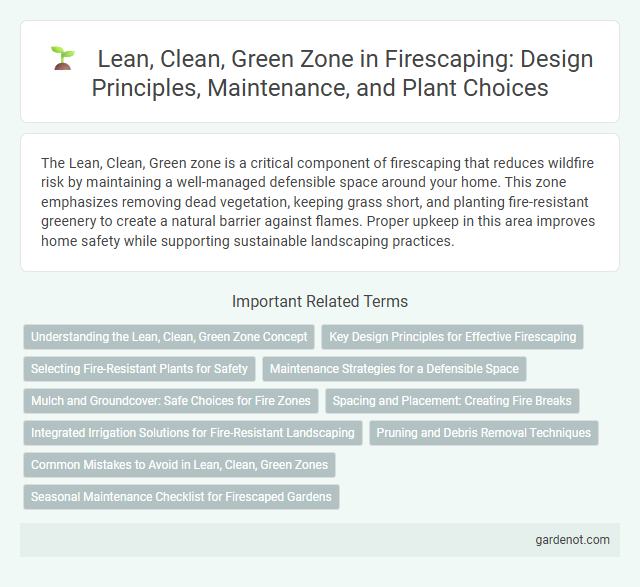The Lean, Clean, Green zone is a critical component of firescaping that reduces wildfire risk by maintaining a well-managed defensible space around your home. This zone emphasizes removing dead vegetation, keeping grass short, and planting fire-resistant greenery to create a natural barrier against flames. Proper upkeep in this area improves home safety while supporting sustainable landscaping practices.
Understanding the Lean, Clean, Green Zone Concept
The Lean, Clean, Green Zone concept in firescaping emphasizes creating defensible space by removing excess vegetation and debris to reduce fire fuel. Maintaining a lean zone with minimal flammable materials, a clean zone free of dead plants and leaves, and a green zone with well-irrigated, fire-resistant plants significantly decreases wildfire risk. This strategic vegetation management enhances property protection and supports fire prevention efforts.
Key Design Principles for Effective Firescaping
The Lean, Clean, Green zone emphasizes reducing combustible materials to create defensible space and enhance fire resistance around properties. Key design principles include selecting low-flammability plants, maintaining minimal fuel accumulation, and optimizing plant spacing to prevent fire spread. Integrating drought-tolerant and native species supports sustainability while improving landscape resilience against wildfires.
Selecting Fire-Resistant Plants for Safety
The lean, clean, green zone in firescaping emphasizes selecting fire-resistant plants that reduce fuel load and minimize fire spread near structures. Choosing native, drought-tolerant species with high moisture content and low resin levels enhances safety by creating defensible space. Regular maintenance, including pruning and removing dead vegetation, further ensures a fire-resilient landscape.
Maintenance Strategies for a Defensible Space
Maintaining a lean, clean, green zone is essential for effective firescaping and creating a defensible space around properties. Regular removal of dead vegetation, pruning of lower tree branches, and keeping grass short reduce fuel loads and fire risk. Utilizing native, drought-tolerant plants with high moisture content enhances fire resistance while supporting environmental sustainability.
Mulch and Groundcover: Safe Choices for Fire Zones
Mulch and groundcovers play a critical role in creating a lean, clean, green zone by reducing flammable materials near structures in fire-prone areas. Opt for fire-resistant mulch types such as gravel, decomposed granite, or rock to minimize ignition risks, while selecting low-growing, drought-tolerant groundcovers like succulents or native grasses that retain moisture and resist spreading flames. Maintaining a clean zone free of dead leaves, dry vegetation, and excessive mulch layers further enhances fire safety and helps prevent wildfire spread.
Spacing and Placement: Creating Fire Breaks
The Lean, Clean, Green zone is a critical firescaping strategy that involves reducing combustible materials and maintaining healthy, well-spaced vegetation to create effective fire breaks. Proper spacing and placement of plants minimize fuel continuity, slowing fire spread and protecting structures. Maintaining this zone ensures defensible space by incorporating fire-resistant species and removing dead or dry foliage.
Integrated Irrigation Solutions for Fire-Resistant Landscaping
The lean, clean, green zone utilizes integrated irrigation solutions to enhance fire-resistant landscaping by maintaining optimal moisture levels in vegetation and soil. Smart irrigation systems combine drought-tolerant plants with efficient water delivery, reducing fuel for wildfires while promoting sustainability. These advanced irrigation technologies support fire prevention efforts by minimizing dry, flammable materials within defensible space areas.
Pruning and Debris Removal Techniques
The lean, clean, green zone in firescaping emphasizes the importance of pruning and debris removal to reduce fire hazards effectively. Pruning involves selectively trimming trees and shrubs to eliminate dead or overgrown branches, improving airflow and sunlight penetration that help maintain plant health and reduce flammable materials. Regular debris removal, including clearing fallen leaves, pine needles, and dead vegetation, minimizes potential fuel loads and enhances fire resilience around properties.
Common Mistakes to Avoid in Lean, Clean, Green Zones
Common mistakes in Lean, Clean, Green zones include allowing excessive plant debris that fuels wildfire spread, improper pruning that creates ladder fuels, and selecting non-native or highly flammable vegetation that undermines fire resistance. Maintaining clear, low-growing, and well-spaced plants can reduce hazardous fuel loads and enhance defensible space effectiveness. Regular removal of dead branches, leaves, and accumulated mulch prevents fire ignition and helps protect structures within these zones.
Seasonal Maintenance Checklist for Firescaped Gardens
Seasonal maintenance of a Lean, Clean, Green zone in firescaped gardens includes regular removal of dead vegetation, pruning trees and shrubs to maintain safe clearance, and clearing leaf litter to reduce fuel load. Emphasizing the use of drought-tolerant native plants minimizes irrigation needs and enhances fire resistance. Consistent debris management and soil health care contribute to a sustainable and fire-safe landscape throughout the year.
Lean, clean, green zone Infographic

 gardenot.com
gardenot.com